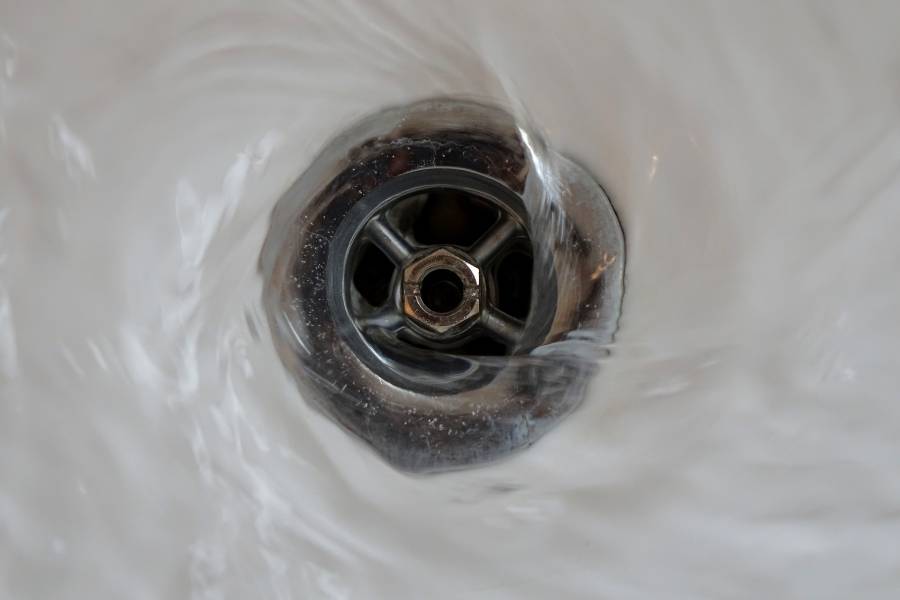Table of Contents
For most homeowners and families, sinks and bathroom drains are rarely taken care of.
We keep seeing the same thing, water draining slowly but taking little action. It is until the sink or bathroom clogs, and we try to find solutions.

Thick black gunk is responsible for slow drainage. Getting rid of the thick black gunk in your sink drain doesn’t have to be expensive.
You don’t need to hire a plumber unless it’s serious. A little confidence and any of the methods on how to get rid of thick black gunk in your sink drain listed below will be enough.
Causes Of Thick Black Gunk In Sink Drain
Ever wondered where the black gunk on your sink drain comes from? Although it’s disgusting, it mainly comes from things we use every day or frequently.
The black gunk for kitchen sinks is because of bacteria from food and sticky fats that get caught up in the sink drain.
For bathroom sinks, the black gunk is due to the accumulation of bacteria from different things on the drain walls. All this delays the flow of water and indicates that the sink drain should be cleaned.
To unclog the sink drain, below are six simple and practical ways to get rid of thick black gunk in your Sink Drain.
How To Get Rid Of Thick Black Gunk In Sink Drain
Make Use Of A Plunger
A clogged pipe may be the source of the gunk blocking your sink; thus, plunging it will clear the obstruction. To achieve the best, you need a rag, sink plunger, and a basin.
Follow these simple steps:
- Plug the overflow hole in the sink with the rag
- Place your sink plunger over the sink drain.
- Pour enough water into the basin to cover the plunger cup
- Short and fast strokes; plunge up and down to drive as much air into the sink drain.
- Remove the plunger and the rag to allow the water in the sink to drain. If it takes a lot of time to drain, repeat the process or use a different method.
Using A Drain Snake
It is another effective way to get rid of the thick black gunk in your sink drain. To get started, you need a snake auger and rubber gloves. A snake auger works by increasing when you spin its handle.
Follow these steps to remove the clog in your sink drain.
- Put the snake auger in the sink drain and start turning the handle to elongate it. Resistance may be felt when the snake’s auger reaches bends.
- Keep rotating until you hit the clogs and feel them break up. If it doesn’t break up, pull the auger off the drain to remove the clog manually.
- To ascertain that the clog has been cleared, flush water down the sink. If it’s not cleared, try other methods.
Using Baking Soda, Vinegar, And Boiling Water
Vinegar has antimicrobial properties. When combined with baking soda, they create a fizzing action that loosens filth and dirt.
If combined with boiling water, they’ll get rid of thick black gunk in your sink drain.
To clean your sink drain, follow these steps:
- Dump as much baking soda in the sink drain as you need. More baking soda is suitable for removing stubborn sink clogs.
- Pour vinegar down the sink drain. As soon as it meets the baking soda, it’ll start boiling and fizzing. Wait for some time as the sludge obstructing the drain disintegrates.
- Carefully pour boiling water down the sink drain. When mixed with vinegar and baking soda, this flushing action will drive away from the black gunk down the drain.
- Wait for a few minutes and test to see if it is working fine.
If you don’t have vinegar, baking soda, and boiling water will work fine. This procedure can still be used with a combination of baking soda, lemon juice, and hot water.
If it doesn’t work, consider repeating it two or more times.

Using Baking Soda, Hydrogen Peroxide, And Boiling Water
Hydrogen peroxide is also effective in unclogging your sink drain. If used appropriately with baking soda, your sink can start working again within minutes.
To get rid of thick black gunk in your sink drain, follow the following steps:
- Mix a cup of hydrogen peroxide and a spoonful of baking soda in a mixing jar.
- Pour this mixture down the drain and wait for it to bubble. It will break down the sludge in the drain pipes.
- Pour the boiling water carefully into the sink drain. It will wash away all the sludge down the drain.
- Run water at room temperature to check if the sink drain is unclogged.
Use A Drain Cleaner And Hot Water
A drain cleaner will dissolve all the clogs in your sink. However, be cautious since it can be abrasive to acrylic or plastic.
You’ll need the drain cleaner, gloves, and boiling water. Make sure you follow the instructions on the drain cleaner label for it to be effective.
Here’s how to clean your sink:
- Carefully pour the drain cleaner into the sink drain. Wait for some time for the sludge to disintegrate. The drain cleaner label has the time indicated.
- Drain the boiling water directly into the sink drain. Let it run for a few minutes to remove the sludge and wash out the drain cleaner.
Manually Clear The Black Gunk From The Pipes
If all the above methods fail, you can manually get rid of thick black gunk in your sink drain. It’s very effective.
You will need a garbage can, wire hanger, bottle brush, paper towels, and unscrewing instruments. You also need hands-on experience in plumbing.
Before starting any work on the sink drain and sink pipes, ensure all water taps are off. Follow the steps below to achieve the best results.
- Disconnect all the pipes under your sink using the tools and the sink maintenance manual instructions.
- Have a look at the inside of the pipes to locate the black gunk. Use the wire hanger or bottle brush, clean all the sludge in the pipe. All this should be put in the garbage can. Wipe out the pipes and your hands using paper towels.
- Reassemble everything and reconnect the water supply. Run water down the sink drain to check if every bit of sludge has been cleared.
Which Is The Best Method To Use?
Manually cleaning the gunk from the sink drain is the best method. However, the other methods are very effective. You should try them before dismantling the sink piping and connections.
If your sink is still clogged after all this, the issue can be down the drain line, necessitating the services of a professional plumber.
Now you have used the above ideas to get rid of thick black gunk in your sink drain, and the water is flowing freely; what’s next?
You need to take a preventive approach to reduce the chances of your sink being clogged again. It can be either changing your sick stopper with one that blocks foreign objects from entering the sink drain.
While some of the above methods are time-consuming and involve pouring toxic chemicals down your sink drain, it’s worth noting you’ll be able to get rid of any odor from sinks and protect your family from diseases.








